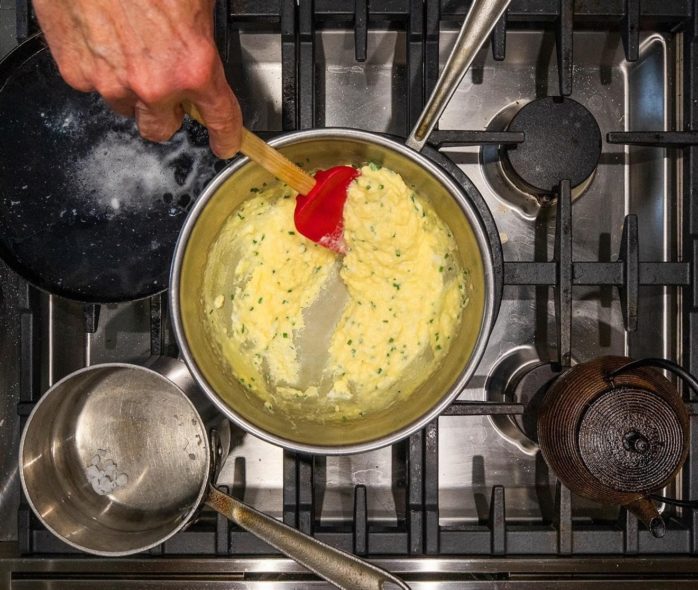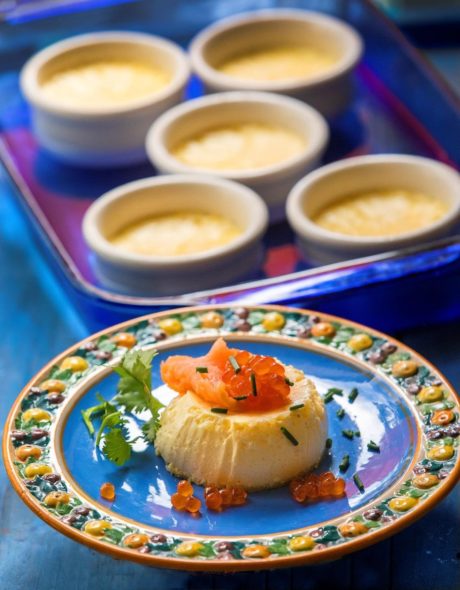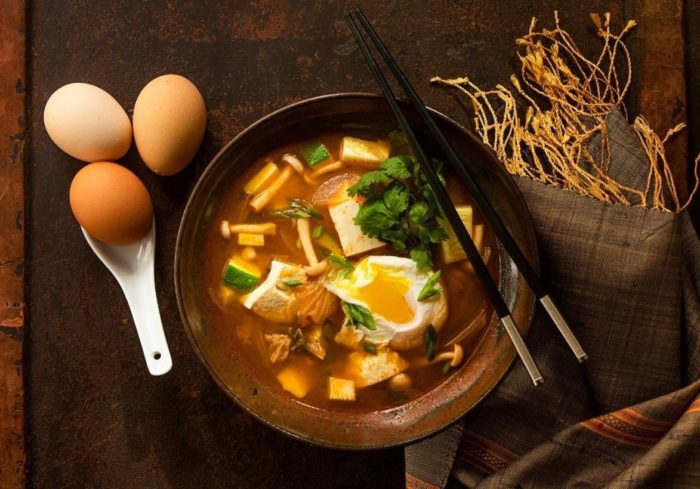Is milk or are eggs nature’s “most perfect food”? If I had a vote, it’d definitely be eggs. Good any time of day they are versatile and nutritious. At only 78 calories each, eggs are a rich source of protein and vitamins. A large egg contains about 6 grams of protein. Eggs also are a good source of vitamin D (which aids bone health and the immune system) and choline (which helps metabolism and liver function, as well as fetal brain development).
Egg yolks also can be good for the eyes; they are significant sources of lutein and zeaxanthin, which have been found to reduce the risk of cataracts and macular degeneration, the leading cause of blindness in people 55 and older.
But egg yolks are also known for their cholesterol, a fact that put them on the no-no list a few years ago. A typical large egg contains 186 mg of cholesterol, more than half the amount previously recommended for daily consumption. Cholesterol is an artery clogging factor in heart disease. In 2015, citing a lack of scientific evidence for a numerical goal, the Federal Dietary Guidelines dropped their concerns about eggs. In support, The Harvard School of Public Health looked at a population of 117,000 nurses and found no difference in heart disease risk between those who ate one egg a week and those who ate more than one egg a day. The Journal of the American College of Nutrition found that eggs tended to satisfy obese and overweight subjects more than a bagel breakfast with an equal calorie count. Eggs look to be a good diet food too!
There is lots to know about the humble egg. The now defunct (unfortunately) Lucky Peach magazine published a great small book on eggs a couple of years ago called (what else?) All about Eggs by Rachel Khong. She noted that among conventional egg producers, unsavory practices are commonplace. There’s “forced molting”: starving chickens so they’ll molt at the same time, go out of production for a couple weeks, and return with rejuvenated reproductive tracts—making them better layers of better-quality eggs. There’s painful, stressful “beak trimming,” which prevents cannibalism and violence when hens are kept in close quarters. There’s no question that seeking out better eggs is well worth it. But when it comes to terminology, what do “Cage- Free,” “Natural,” “Organic,” “Omega-3,” and on and on, really mean when you see them on the carton?
Natural: Means nothing. Think about it. Everything comes from nature, even gasoline and Velveeta. The USDA declares that egg products are natural when they contain no artificial ingredients, added color, and are only minimally processed. Anything other than an Easter egg would probably qualify as natural.
Cage-Free: According to the USDA, a cage free chicken “[can] freely roam a building, room, or enclosed area with unlimited access to food and fresh water during their production cycle but does not have access to the outdoors.” Though this is an upgrade from the conventional battery cage (roughly 8.5 x 11 inches), cage-free facilities, while allowing their hens more space, have much higher mortality rates (often the result of hen-on-hen violence) and lower air quality than facilities that use cages.
Free Range: Unlike cage-free hens, free range hens must have access to outdoor space. It doesn’t have to be much—sometimes it’s a cat door to a screened-in porch.
No Added Hormones: This simply means that the egg-laying hen did not receive hormones. Which is a funny thing to mention, because administering hormones and steroids to poultry is prohibited across the board by the FDA. All eggs sold in the U.S. are hormone free.
No Added Antibiotics: This term is regulated by both the USDA and FDA and means an egglaying hen received no sub-therapeutic antibiotics. But only a very small percentage ever receive added antibiotics to treat sickness, and their eggs are “diverted from human consumption” anyway.
Vegetarian Fed/Feed: “Vegetarian Fed/ Feed” means an egg-laying hen was fed a diet devoid of any animal products during its production. Which is actually kind of sad! Hens aren’t naturally vegetarian, but omnivorous (they love worms and bugs). That said, conventional hens who aren’t vegetarian fed are not likely being fed those worms and bugs they love so much, but a diet rich in animal byproducts, from feather meal to chicken litter. So really, when you’re buying vegetarianfed eggs it’s a lesser-of-two-evils situation.
Local: A term regulated by the USDA, “local” eggs must have come from a source flock located less than four hundred miles from their processing facility or within the state where the eggs originated and were processed.
Organic: Eggs marked with the USDA’s National Organic Program label were laid by uncaged hens that are technically free to roam and have access to the outdoors, in addition to being fed an organic diet produced without conventional pesticides or fertilizers. Which all sounds good and is for the most part great—organic is a pretty decent option. But the problems with organically produced eggs are the same as those for free-range: the absence of cages in a barn or poultry house doesn’t usually translate to a wealth of actual free-roaming space per hen, and what qualifies as access to the outdoors can be as insignificant as a cat door to a wired-in patch of cement.
Omega-3 Enriched: Eggs with higher levels of omega-3 fatty acids come from hens that were fed diets high in fatty acids: anything from flax to chia seeds to fish oil to algae, added to a bird’s regular wheat- and/or corn- and/or canola-based foodstuff. Omega-3-enriched egg cartons are required by the USDA to state the amount each egg contains. It can have five times the concentration of omega-3s than conventionally raised or free-range eggs.
Pasteurized: Pasteurization occurs when an egg is heated to destroy pathogens especially salmonella. Egg containing products are required to be pasteurized. It’s regulated by the FDA. In addition to all the hubbub mentioned above, eggs can be certified by third parties, further complicating this task of ingredient buying

John Burgess Santa Rosa Press Democrat
FRENCH SCRAMBLED EGGS
The French among others are very particular about cooking eggs. I remember my French chef instructors telling me that it should take several minutes to properly scramble an egg. Here’s a simple recipe which illustrates the technique.
Serves 4
8 large eggs
1/2 teaspoon salt or to your taste
Freshly ground pepper (preferably white) to your taste
1 tablespoon finely chopped fresh tarragon or 3 tablespoons finely chopped chives 3 tablespoons crème fraiche or natural cream cheese (without stabilizers)
Add an inch or so of water to a large saucepan and bring it to a simmer over medium heat. In a stainless mixing bowl that will fit on top of the pan but not touch the water, whisk the eggs, salt and pepper until very smooth. Stir in the tarragon and crème fraiche and place bowl over the simmering water.
With a rubber spatula constantly stir the mixture scraping over the bottom and sides of the bowl so that the eggs cook very slowly. The idea here is to take at least 5 minutes to cook the eggs so regulate (lower) the heat accordingly. Cook the eggs until they are soft, custardy and will hold their shape on a spoon but are still very soft. Remove the bowl from the heat and continue to stir for another half minute or so.
Serve on warm plates as is. If desired you can top with whatever sauce, grated cheese or sauteed vegetable that you like.
CLASSIC EGG SALAD AND VARIATIONS
Makes about 2 cups
Every cook has their own variation. I wouldn’t want to argue with your Mom or Grandma about
which is best. Here’s my version. Egg salad is best served freshly made, but it can be refrigerated up to 1 day in advance. Great for a sandwich, on crostini or in crisp romaine leaves.
7 large eggs
1/4 cup mayonnaise
2 teaspoons dijon mustard
A few shakes (about 1/8 teaspoon total) your favorite hot sauce, or to taste
1 tablespoon sweet pickle relish or to your taste
Freshly ground black pepper
Fill a mixing bowl with cold water.
Bring a large saucepan of water to a boil over medium-high heat. Use a slotted spoon to gently lower in the eggs and cook for 7 minutes. Remove the saucepan from the heat; use the slotted spoon to transfer the eggs to the bowl of cold water.
Place the bowl of eggs in the sink and run cold water into the bowl for a couple of minutes. Crack the eggs all around and under a very gentle stream of cold water, peel them. The running water helps separate the shell from the egg.
Meanwhile whisk together the mayonnaise, mustard and hot sauce in a small nonreactive bowl. Stir in the pickle relish, then season with pepper to your taste.
Place the eggs in a mixing bowl. Use a potato masher to break them into small chunks. Fold in the mayonnaise mixture, including any of the variations below. Refrigerate until ready to serve.
VARIATIONS: Any one of the following ingredients would be a tasty addition: 4 teaspoons snipped fresh dill; 4 teaspoons coarsely chopped fresh parsley; 2/3 cup diced smoked ham; 2/3 cup diced steamed shrimp; 1/4 teaspoon smoked paprika (pimenton; whisk it into the mayonnaise mixture); 3 tablespoons diced roasted red pepper.
MAMAN’S EASY CHEESE SOUFFLÉ
Serves 4
This is a very slightly recipe adapted from Jacques Pépin. Maman in French means “mom.” Jacques notes that unlike traditional French soufflés that call for separating the eggs, adding the yolks to the white sauce, beating the egg whites till stiff, and gently folding them in, this recipe has you beat the eggs straight into the sauce. When Jacques’ mother was newly married at seventeen, no one told her the eggs needed to be separated but it worked! The results are less airy, but every bit as delicious and easier.
You can also make the whole thing well ahead of time. As the Washington Post noted when they printed this recipe “Let the mixture hang out at room temperature for a couple hours, or in the fridge for a day. When you’re ready to bake, heat your oven and go. Pépin’s daughter Claudine wrote, “We usually serve it as a first course, but we love it for brunch and meatless dinners as well.”
6 tablespoons unsalted butter, plus additional to butter a 5- to 6-cup gratin dish
1/4 cup finely and freshly grated Parmesan cheese
6 tablespoons all-purpose flour
2 cups whole milk
1/2 teaspoon salt
1/2 teaspoon freshly ground black pepper
6 large eggs
- 1/2 cups grated Swiss cheese, preferably Gruyère (about 6 ounces), plus three more optional slices for garnish (roughly 2-inch by 3-inch)
- tablespoons minced chives
Heat the oven to 400 degrees. Butter a 5- to 6-cup gratin dish, sprinkle the bottom and sides with half the Parmesan to lightly coat. Set it aside. Melt the 6 tablespoons of butter in a saucepan, then add the flour and mix it in well with a whisk. Cook for 10 seconds, add the cold milk in one stroke and mix it in with a whisk. Keep stirring with the whisk until the mixture thickens and comes to a strong boil, about 2 minutes. It should be thick and smooth. Remove from the heat and stir in the salt and pepper.
Break the eggs into a bowl and beat well with a fork. After about 10 minutes, the white sauce should be cool enough to proceed. Moving quickly, add the eggs, cheese and the chives to the sauce, and mix well to combine. Pour into the buttered gratin dish and cook immediately or set aside until ready to cook. If setting aside for a few hours, the soufflé can remain outside at room temperature. If assembling a day ahead, refrigerate and bring back to room temperature before baking.
Sprinkle the surface with the remaining 2 tablespoons of Parmesan and arrange the 3 slices of Gruyère in a circle in the center, if using. Bake for 30 to 40 minutes, or until puffy and well browned on top. Although it will stay inflated for quite a while, it is best served immediately.

John Burgess Santa Rosa Press Democrat
SAVORY CHEESE CUSTARD
Serves 6
A simple custard is a wonderful foil for smoked salmon, a lively tomato sauce, to serve with sautéed greens or mushrooms or to use as the centerpiece for a salad of peppery greens dressed with a simple vinaigrette. All kinds of fresh herbs and other cheeses can be added to the custards.
2 tablespoons melted butter
2 large eggs
2 egg yolks
1 cup milk
1 cup heavy cream
1/4 teaspoon freshly grated nutmeg
3/4 teaspoon kosher salt
1/2 teaspoon freshly ground pepper, preferably white
3/4 cup freshly grated Parmesan, Dry Jack or aged goat cheese
Preheat oven to 350 degrees. Brush six 6-ounce custard cups with melted butter and place these in a 9 x 13 baking pan.
Whisk the eggs and yolks together and then whisk in the milk, cream and nutmeg until well blended. Stir in salt and pepper to your taste and then stir in the cheese. Divide the mixture among the custard cups.
Place the pan with the custards in the oven and carefully pour enough hot water to come halfway up the sides of the cups. Bake until custards are set, about 30 minutes. Carefully remove pan from oven and transfer cups to a rack.
Serve warm directly from the cups or cool and run a thin knife around the edge of each cup and invert the custards onto plates.

John Burgess Santa Rosa Press Democrat
MEXICAN EGGS IN PURGATORY
Serves 4
A riff on the Italian breakfast dish Eggs in Purgatory, where eggs are baked in a spicy tomato sauce. In this Mexican-inspired take, I have substituted a vibrant, fresh green sauce made with tomatillos.
1-pound tomatillos, husked and coarsely chopped
1 medium poblano stemmed and seeded
1 teaspoon stemmed and seeded serrano chile
1 1/2 cups roughly chopped cilantro leaves and stems
3 scallions including greens, coarsely chopped saving some for garnish
3/4 cup chicken broth
3 strips thick sliced bacon, chopped
2 tablespoons extra-virgin olive oil
- garlic clove, minced
1/2 teaspoon brown sugar
- teaspoons soy sauce
Kosher salt and freshly ground pepper to taste
4 large eggs
3 tablespoons grated Cotija or parmesan cheese , plus more for garnish Warm corn tortillas, for serving
Preheat the broiler and position a rack about 8 inches from the heat source. In a blender or food processor, add the husked tomatillos, poblano, serrano, chopped cilantro, chopped scallions and chicken broth and puree until smooth.
In a large, shallow flameproof casserole or skillet, cook the bacon in the olive oil over moderately high heat until the bacon is browned, about 4 minutes. Remove with a slotted spoon and set on paper towel to drain. Add the minced garlic and cook for 30 seconds, until fragrant. Add the tomatillo puree and cook over moderate heat until the sauce is thickened and dull green, about 6 minutes. Add sugar and soy sauce and season to your taste with salt and pepper.
Using the back of a spoon, make 4 depressions in the tomatillo sauce. Remove the casserole from the heat and carefully crack the eggs into the depressions. Sprinkle the eggs and tomatillo sauce with the 3 tablespoons of Cotija cheese. Broil the dish until the egg whites are set but the egg yolks are still runny, about 4 minutes. Garnish with more Cotija cheese, reserved bacon and chopped scallions and serve right away with warm corn tortillas.
Note: The green tomatillo sauce can be refrigerated covered for up to 2 days. Heat the sauce before adding the eggs.

John Burgess Santa Rosa Press Democrat
KOREAN KIMCHI SOFT TOFU STEW
Serves 4
Known in Korean as Soondubu Jjigae, this one of my favorite go-to, healthy dishes. Chile garlic paste, soft tofu and kimchi are available in many markets but of course always in Asian markets.
1 tablespoon vegetable oil
1 medium onion, peeled and sliced
- teaspoon Korean or other Asian chile garlic paste, or to taste
- cups zucchini cut in large dice
1 tablespoon finely minced ginger or to taste
3/4 cup shimeji mushrooms lower stems cut and discarded (optional)
1-1/2 cups or so cabbage or daikon kimchi, coarsely chopped
3 cups or so vegetable or chicken broth
1 teaspoon soy sauce or to taste
6 – 8 ounces silken tofu, drained
4 large eggs
2 medium scallions, both white and green parts thinly sliced at an angle Steamed white or brown rice, for serving
Heat the oil in a heavy bottomed soup pot over medium heat. Add the onion and cook, stirring occasionally, until just beginning to soften.
Add the chile paste, stir to combine, and cook until fragrant, about 1 minute. Add the zucchini, ginger and mushrooms if using and stir to combine. Add the kimchi and cook, stirring occasionally, until simmering, about 2 minutes. Add the broth and soy sauce and bring to a boil.
Using a large serving spoon, add the tofu by very large spoonfuls, taking care not to break up the tofu into little bits. Gently press down on the tofu with the back of the spoon so that the broth is mostly covering it. Simmer until the tofu is heated through and the flavors have melded, about 3 minutes. Taste and add more kimchi, broth and/or soy sauce to your taste.
Meanwhile poach the eggs in simmering water to which you’ve added a little white vinegar. Whites should be set but yolks still runny, about 3 minutes. Divide the stew among 4 bowls, being careful not to break up the tofu. Top with the eggs and sprinkle scallions over. Serve immediately with rice on the side.
GREENS, EGGS, NO HAM
Serves 1
We all need a few quick and healthy dishes when we are cooking for ourselves. Here’s one of my favorites that can be done in less than 5 minutes. It’s inspired by Dr. Seuss’s beloved children’s classic Green Eggs and Ham.
- slice good whole grain or crusty artisan bread such as ciabatta
- teaspoons unsalted butter or olive oil
1/4 cup chopped scallions (1 large) including the green tops
2 cups lightly packed savory young greens, such as arugula, baby spinach and/or watercress Kosher or sea salt and freshly ground black pepper
2 tablespoons or so freshly grated Parmesan or Pecorino cheese 2 eggs
Toast the bread lightly and set in the middle of a plate or shallow bowl.
Meanwhile heat 1 teaspoon butter in a small nonstick skillet over moderate heat. Add the scallions and sauté for a minute or so or until softened. Add the greens and sauté for another minute so that they just begin to wilt. Season to your taste with salt and pepper and place on top of toast. Sprinkle half the cheese on top of that.
Place remaining teaspoon of butter in the skillet. Break the eggs into the skillet and cook them sunny side up or done to your liking. Place on top of greens and sprinkle with remaining cheese. Immediately invert the skillet over the eggs and let stand for a minute or two to melt the cheese and firm up the eggs.
John Ash © 2021

